Last week I did some repair work at WDDY in Albany NY. It seems the sample line on one of the towers was melted in half by a lightning strike. This station uses sample loops up on the tower for its directional antenna monitoring system.
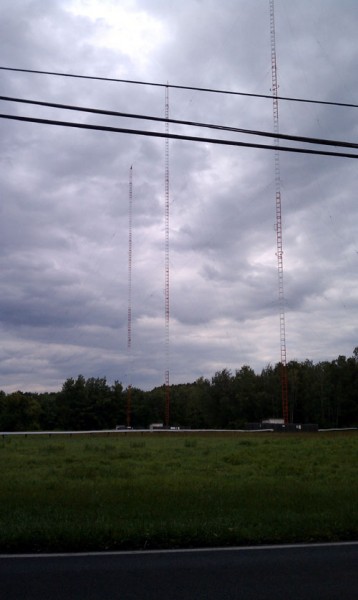
As it happened, the sample line in question was on the reference tower, which makes everything else meaningless. Before the meltdown, there were several years’ worth of maintenance logs that showed the previous values for current ratio and phase relationship.
With the transmitter turned off and locked out, I removed the damaged section of the line from the base of the tower to the RF choke coil in the tuning house. Where the sample line came off of the base of the tower, there was a UHF-type connector that had been improperly applied. Using spare parts, I fixed that connector, then spliced the line into place. Upon power-up, the transmitter and antenna readings returned to their previous values, which were slightly out of tolerance.
Thus, some phasor tuning was needed. There are not too many people left that can properly tune an AM phasor. All of the control interact with each other; moving the power or phase to one tower will likely affect all of the other towers and possibly the reflected power on the transmitter. This phasor was made in the 1970s by Multronics with what looks like all RCA parts. Multronics, I think, was John Mullaney who is more known for the folded unipole antenna. In any case, after a good few hours of careful hand cranking and a run out to the reference tower to move a coil tap, here are the results:
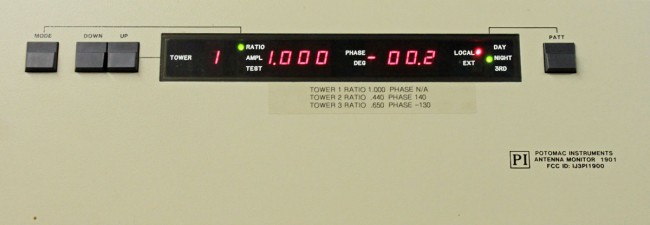
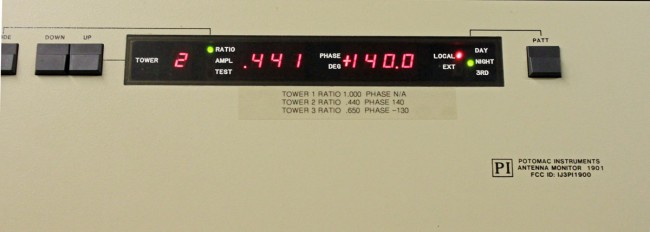
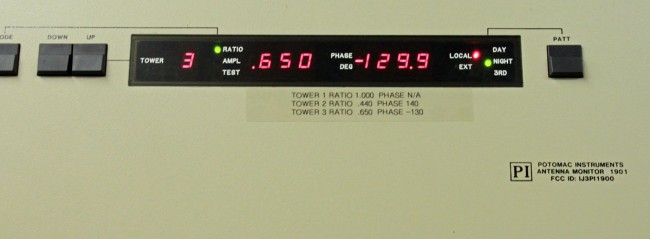
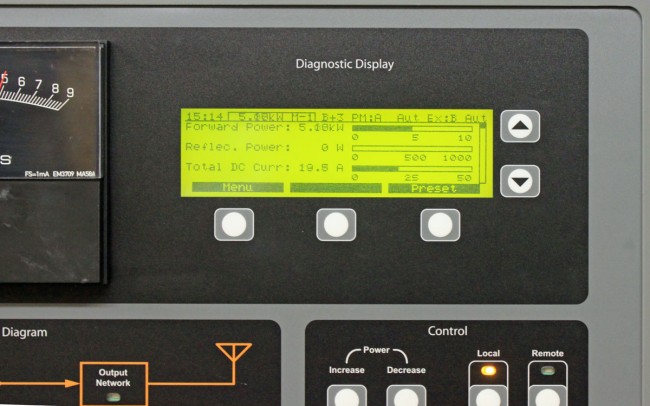
Not bad for a day’s work.



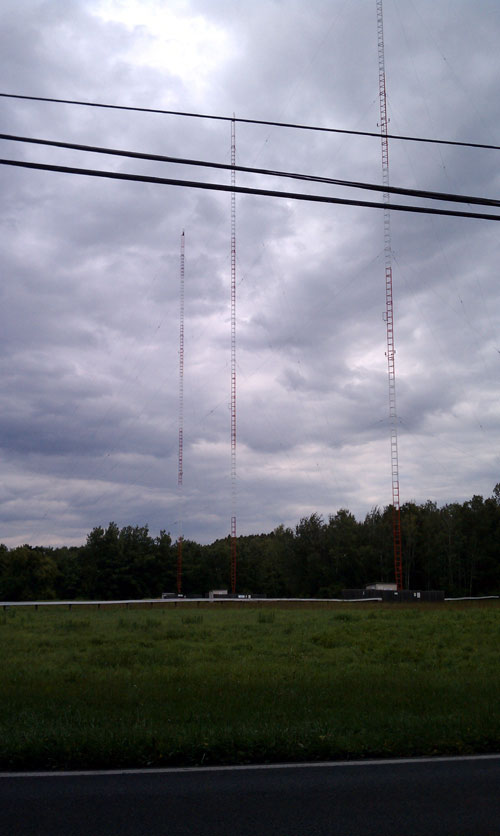


I love it, there are few of us remaining that have a clear understanding of proper AM antenna maintenance and repairs especially directionals. Sad to say we are dropping like flies and there will be no one coming up to replace us….m funny it may not be necessary as directional arrays are disappearing just as fast.
How’s field strength at the monitor points now?
WDDY (ex. WGNA) was very clearly listenable in Springfield. When I was younger, I would listen to WGNA (which at the time was //FM) to hear commercials from Albany, which made me think of home.
Roberta, the monitor points were never out of tolerance, the signal strength is pretty much the same as it was before. This was more an exercise in making the numbers on the antenna monitor match the numbers on the license.
Mike, WGNA-AM was kind of a throw away signal that Barnstable did not know what to do with. It would be nice if somebody local acquires it and does something good. It has a pretty good signal over downtown Albany/Troy.
🙂 I figured they had to’ve been close all along. You’re right, it’s a good day when the antenna monitor reads what the license says it should. –Too many DAs I worked with were fighting with a lousy array/poor grounds/et-headache-cetera and at the end of the day, I’d go home thinking, “At least the nulls are right,” and come back to deal with the thing the next day. I spent what seemed like a century of overnights one summer running all the radials for a 5 kW DA-N after we’d replaced the phasor and had a new set of base insulators stuffed under a 1937 straight-leg self-supporting tower. The original phasor was an RCA with 70 Ohm input! Pity the day tower was fed with 50 Ohm coax and the previous crew was just retuning twice a day. That’s a little hard to do with a modern-sized engineering staff. (This was, comparatively speaking, back in the dark ages. The “new” transmitter was load-picky Collins Power Rock, backed up by an RCA BTA-5U that I believe would load up into a coat hanger; we ran it into a base-shorted tower for about five minutes one day when an Austin failed.)
Chris Hall commented:
Sad to say we are dropping like flies and there will be no one coming up to replace us.
Chris, I have tried for years to get a position where I can train and learn about AM DAs, even down to asking CEs if they need an extra hand on weekends or evenings *for free* when they do their transmitter duties. I’ve been turned down every time. It cannot be because I’m not competent — I’ve been around radio in all forms since 1979 and I haven’t killed myself yet.
I’m sorry to say this, but guys that refuse to share the knowledge that is keeping them employed are the ones choking off the influx of interested engineers, assuring the industry that no one is “coming up”. Their mystical secrets will retire along with them, and I think that’s appalling.
In some cases, it’s job security. With engineering staff being spread out so thin these days, a working engineer is a happy engineer, and when someone a bit younger comes around who’s willing to work for less money, that’s the only thing the station ownership ever looks at – the bottom line – and they get rid of the knowledgeable guy for someone cheaper, especially before any sort of pension might kick in. It’s unfortunate that this sort of cut-throat business model is what’s being taught to all the MBAs. Come in, make a quick profit for yourself in 6-12 months, don’t worry about who you step on or bury along the way, then move on. How many stations, and businesses, can you think of where this has happened.
Broadcast engineering isn’t like the medical profession where students learn at college, then take up internship and residency, then partnership, then go out on their own. As sad as it is to be unable to learn from the existing engineers, the equipment is just getting too reliable. Station design is getting simpler and easier; just let someone else do it. It’s rare these days to fix something down to the component level; most equipment manuals tell you to replace the largest assembly possible, usually this means you start at the power wiring and get a fork lift so you can ship it back to the factory. Yes, there’s still maintenance of existing stations, but perhaps this is just someone’s way of thinning the herd, getting rid of some really old stations that need to be torn down anyway, the ones whose towers are rusting away and have poor/no ground systems.
What Bob said. I left radio for TV 20+ years ago and in six months was making more as an Engineering Maintenance Tech than I had been as CE for the market’s top-rated FM. Consolidation has actually helped that a little, from what I hear, fewer jobs but better pay and not so much incentive to “moonlight.”
TV is presently going through a process of downsizing — “right-sizing?” — in much the same way radio did and for the same reasons: shrinking profits, improved equipment reliability. And with the same cost in institutional knowledge. We already nearly lost Dielectric.
‘Tis an interesting discussion. On the one hand, passing along knowledge to the younger guys has always been a part of the job. While college physics and electronics give good theory, actually turning the phasor cranks and watching what each one does and how they all interact is invaluable experience. That is how I learned about AM directionals.
One the other hand, the work force structure has changed quite a bit. Many engineers are now contractors who get paid an hourly rate. Is the station going to foot the bill for all of the instruction time? I am self employed and as such, have a fair amount of overhead. Things like vehicles, tools, insurance, office space, self employment tax, etc. What I am looking for is billable hours. That is the reality of broadcast engineering today.
Alan P, I don’t know if you were brushed off by people unwilling to share, it’s more likely a matter of liability. I know that my former station’s management would not permit guests at transmitter sites because of liability concerns.
No Jim, it was everything but.
— “Directional AM is too complex, you’d never get it”…
— “Do you know how long it takes to learn this?”…
— “We could lose our license”…
— “You could die”…
— “Start someplace small to get some experience” (I heard that when I was in my late 30s and had been involved in radio for almost 20 years. How much experience did this guy think I needed to at least qualify as ‘curious’?)
In all the time I’ve been doing this, I’ve known only three CEs along the way that respected my RF interests enough to offer some attention — one was in Syracuse NY, one in DC and one in Connecticut. That’s an awful lot of RF guys in-between that BS’d me.
I’ve learned what I can with RF theory books, websites and amateur radio. The rest, well ….
I love reading blog posts like this as I’m a 32 year old still aspiring to be a Broadcast Engineer someday! Unfortunately, even though I have a lot of “book” experience, here in Portland nobody is interested unless you have “field” experience.
I just keep up my skills building and troubleshooting kits and equipment (I am an amateur radio license holder) with the hope that someday the right opportunity comes up!
Alan P., I read your reply with dismay, and can’t understand the kind of treatment you received from our brethren. I entered radio engineering during college, and landed the CE gig at my first directional station two years later not knowing much about directionals except what I learned from the NAB handbook. I don’t really think it is any more difficult to land a job at a directional AM station now than it was back then except that there are fewer jobs and fewer radio engineers. When you get past the theory, much of AM antenna maintenance comes down to doing plumbing, keeping connections tight and troubleshooting relay logic. Failures are often real obvious and easily spotted. You can learn the deeper theory of operation along the way. Bottom line is that if you want to do it badly enough, there is somebody out there willing to hire you. I think that the engineers that blew you off just didn’t have the time or personality to devote to mentoring which is highly unfortunate for both you and the industry.
Yeah, you can’t get that sort of experience with directional antennas without a ham radio license, building your own miniature phasors, and putting up a pair of antennas. But then you’ve got the problem that you’re studying RF without transmitting information, which is generally frowned upon in ham radio.
OTOH, you can use an antenna analyzer for some information and cobble together some other gear to come up with the rest.
Probably just easier to spend the time and learn how to use some (free) MoM software or NEC2.
I wonder when corporate radio will start using distributed or single-site computing power for processing information.
I guess what I’m saying is… you have options if you study the basic, root material and learn how to use available test equipment to get the answers you need rather than spending money on buying or renting the $40K Vector Network Analyzer (VNA). Then the practical experience helps more because you can see the effects of calculus in real time on various instruments and get a feel for what is going on.
I am always looking to learn more about broadcast engineering. Directional AM is always a mystery to me, even though i am in charge of one. So if anyone of the “older” guys want to ever take on the challenge of teaching the “younger” guys how to tune it properly. Hit me up, i’m open to sykping or email explanations. Love the website and the stories. keep it up!